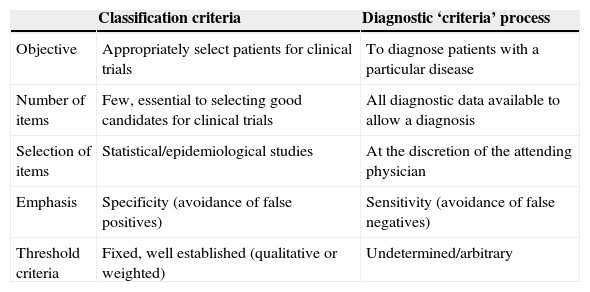Over time I have become more and more surprised with the emphasis placed on courses and conferences that distinguish between criteria for classification and diagnosis. The argument is that the classification criteria have been designed to select patients who will be included in a clinical trial and, therefore, their greater certainty and consistency seek to obtain stable and comparable populations from one study to another. The diagnostic criteria, on the other hand, would be those that establish a diagnosis in individual patients and can be used in daily clinical practice.1Table 1 describes the characteristics that distinguish them in practice. I will explain why, in my opinion this division into two types of criteria is fallacious, and why the existence of different criteria is a myth, because in actual practice we all use the criteria for classification as diagnostic criteria.
Differences Between Criteria for Classification and Diagnostic Criteria.
| Classification criteria | Diagnostic ‘criteria’ process | |
|---|---|---|
| Objective | Appropriately select patients for clinical trials | To diagnose patients with a particular disease |
| Number of items | Few, essential to selecting good candidates for clinical trials | All diagnostic data available to allow a diagnosis |
| Selection of items | Statistical/epidemiological studies | At the discretion of the attending physician |
| Emphasis | Specificity (avoidance of false positives) | Sensitivity (avoidance of false negatives) |
| Threshold criteria | Fixed, well established (qualitative or weighted) | Undetermined/arbitrary |
First, we must note that the process of medical diagnosis is in itself a classification process,2 which starts from a set of data and transforms into a theoretical construct that we name a disease, such as rheumatoid arthritis (RA) or ankylosing spondylitis (AS). Over time, doctors have tried to make a nosologic classification of diseases based on their differences in clinical signs, evolution and response to treatment. This classification has changed as we acquire more or better evidence of the differences between the nosological constructs. The paradigmatic example is ankylosing spondylitis, initially interpreted as a form of rheumatoid arthritis, or ankylosing vertebral hyperostosis (AVH) that required a war between the pater familias of international rheumatology (Forestier vs SCHMORL with Rotés Querol in between), until it was recognized as an entity distinct from AS. Thus, disease classifications are modified over time and therefore it is not surprising that their diagnostic criteria do so as well. As a nosological classification system, we have widely accepted the International Classification of Diseases (ICD) which is now in version 10.3
In any case, the aim during the diagnostic process is to fit the morbid details of a patient (and the patient itself as a consequence) inside one of the boxes in the available diagnostic classification. In other words, when performing a diagnosis we also carry out a classification process. And on what basis do we make this diagnosis/classification process? In a series of more or less constant and predictive data in a group of subjects with the disease in question; of course, these data coincide in most cases with that used in the so-called classification criteria. An important point is that these criteria are a limited subset of the events that may occur in a disease, because in the classification criteria there are typically deleted items that are redundant or which have collinearity (highly correlated with each other), as well as the late or uncommon manifestations of disease. Therefore, the dataset used for diagnosis is greater than that used in the classification criteria. But this does not mean that the classification criteria are different from the so-called diagnostic criteria. In fact, I have not found a differential formal description of such criteria in any publication, as only the classification criteria are always described.
The classification criteria, like many things in medicine, are not completely perfect, having a certain sensitivity and specificity for the diagnosis, as made by experts, something that usually is not a gold standard but a consensus based on their own experience. There is a certain relationship between the classification criteria and the actual disease state of the patient, whose diagnosis is usually based on the experience of expert clinicians, but not on formal diagnostic criteria, unless there is a specific gold standard (biopsy or pathognomonic finding).
What is clear is that, in general, patients who meet criteria may be diagnosed with the disease, so often these criteria are the basis used to confirm the suspected diagnosis. The reverse is not always true: some patients who fail to meet criteria may also be diagnosed using additional data to that included in the classification criteria.
To summarize, the concept of diagnostic criteria is fallacious because they either overlap with the classification criteria or are not formally well defined and simply refer to the concept of diagnosis based on experience. Consequently, the habit of comparing the two types of criteria in publications and conferences should be abandoned, because it is based on a misunderstood and inappropriate concept. The classification criteria are also diagnostic criteria, although it must be emphasized that reaching the clinical diagnosis in some patients may require additional data that are included in the classification criteria being used.
FundingNone.
Conflict of InterestThe author declares no conflict of interest.
Please cite this article as: Belmonte-Serrano MA. El mito de la distinción entre criterios de clasificación y criterios diagnósticos. Reumatol Clin. 2015;11:188–189.






